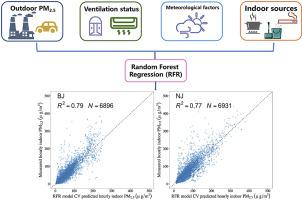当前位置:
X-MOL 学术
›
Build. Environ.
›
论文详情
Our official English website, www.x-mol.net, welcomes your feedback! (Note: you will need to create a separate account there.)
Estimating hourly average indoor PM2.5 using the random forest approach in two megacities, China
Building and Environment ( IF 7.4 ) Pub Date : 2020-08-01 , DOI: 10.1016/j.buildenv.2020.107025 Chunyu Xu , Dongqun Xu , Zhe Liu , Yunpu Li , Ning Li , Ryan Chartier , Junrui Chang , Qin Wang , Yaxi Wu , Na Li
Building and Environment ( IF 7.4 ) Pub Date : 2020-08-01 , DOI: 10.1016/j.buildenv.2020.107025 Chunyu Xu , Dongqun Xu , Zhe Liu , Yunpu Li , Ning Li , Ryan Chartier , Junrui Chang , Qin Wang , Yaxi Wu , Na Li

|
Abstract This study developed a predictive model for hourly indoor fine particulate matter (PM2.5) concentration based on the random forest regression (RFR) method and compared its performance with the traditional multiple linear regression (MLR) method. The concentrations of indoor and outdoor PM2.5 were monitored at a total of 66 apartments in Nanjing (NJ) and Beijing (BJ), China, during both the heating and non-heating seasons. In total, 14,442 pairs of hourly indoor and outdoor PM2.5 were measured by light-scattering nephelometer, while potential influencing factors were obtained via questionnaires. Hourly indoor PM2.5 prediction were developed based on either the RFR or MLR method. A ten-fold cross-validation (10-fold CV) analysis was used to evaluate the predictive power of the models. The 10-fold CV results revealed the MLR models agree fairly well with the measured data, with coefficients of determination (R2) ranging from 0.70 (BJ) to 0.73 (NJ), while the root mean square error (RMSE) ranged from 28.0 μg/m3 (NJ) to 28.2 μg/m3 (BJ). Overall, the RFR models outperformed the reference MLR method as indicated by higher CV R2 (0.82 in BJ and 0.78 in NJ, respectively) and lower CV RMSE (20.4 μg/m3 in BJ and 24.3 μg/m3 in NJ, respectively). Our results show that the RFR approach can exceed the predictive power of the classic MLR method and is a promising methodology for estimating indoor PM2.5 concentrations in Chinese megacities when direct PM2.5 measurements are not possible.
更新日期:2020-08-01



























 京公网安备 11010802027423号
京公网安备 11010802027423号